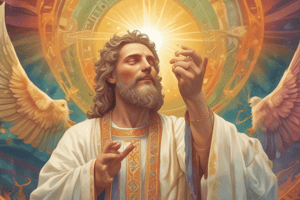Podcast
Questions and Answers
What is the author's point about self-deception?
What is the author's point about self-deception?
- It is a sign of spiritual maturity.
- It is only present in those who do not have faith.
- It is easy to overcome through self-effort.
- It is an obstacle to spiritual growth that cannot be overcome through instruction alone. (correct)
What is the result of having self-sins, according to the author?
What is the result of having self-sins, according to the author?
- Freedom from the power of sin.
- The opaque veil that hides the Face of God from us. (correct)
- A deeper understanding of God's love.
- A stronger sense of self-righteousness.
What is required to remove the veil of self-sins, according to the author?
What is required to remove the veil of self-sins, according to the author?
- Participation in Bible conferences and evangelism.
- Human effort and self-control.
- Mere instruction in Christian doctrine.
- Spiritual experience and a work of God in destruction. (correct)
What is the author's perspective on the process of 'rending the veil'?
What is the author's perspective on the process of 'rending the veil'?
What is the danger of 'lazy acceptance' in the context of self-crucifixion, according to the author?
What is the danger of 'lazy acceptance' in the context of self-crucifixion, according to the author?
What is the ultimate goal of dying to self, according to the author?
What is the ultimate goal of dying to self, according to the author?
What does the author mean by the 'opaque veil'?
What does the author mean by the 'opaque veil'?
What is the relationship between the cross and self-crucifixion, according to the author?
What is the relationship between the cross and self-crucifixion, according to the author?
What is the author's prayer at the end of the passage?
What is the author's prayer at the end of the passage?
What is the author's tone throughout the passage?
What is the author's tone throughout the passage?
What is the nature of the 'veil' that hides the Face of God from us?
What is the nature of the 'veil' that hides the Face of God from us?
What is the outcome of trying to instruct oneself out of self-sins?
What is the outcome of trying to instruct oneself out of self-sins?
What is the necessary step towards removing the veil of self-sins?
What is the necessary step towards removing the veil of self-sins?
What is the danger of 'lazy acceptance' in the context of self-crucifixion?
What is the danger of 'lazy acceptance' in the context of self-crucifixion?
What is the ultimate outcome of the cross doing its deadly work within us?
What is the ultimate outcome of the cross doing its deadly work within us?
Flashcards are hidden until you start studying
Study Notes
The Divine Purpose of Humanity
- Augustine's insight: "Thou hast formed us for Thyself, and our hearts are restless till they find rest in Thee,” encapsulating humanity's need for a relationship with God.
- The Shorter Catechism states that the chief end of man is to "glorify God and enjoy Him forever."
- Humanity was created for God's pleasure, meant for divine communion and to draw life from His presence.
The Separation from God
- The fall of man signifies a "foul revolt," leading to a breach in the relationship with God, resulting in guilt, fear, and restlessness.
- Omnipresence of God cannot be escaped; humans strive to flee from His manifest presence, similar to Adam hiding in the garden.
- Life on Earth reflects a struggle away from the divine presence, resulting in a longing for restoration and reconciliation with God.
Redemption and Return
- God's redemptive work aims to restore the relationship severed by sin, requiring the satisfaction of sins and full reconciliation.
- The process of return begins with a yearning for God’s presence and the desire to "arise and go to my Father."
- The Old Testament tabernacle serves as a metaphor for the journey from sin to divine communion, involving stages of sacrifice and purification before reaching the Holy of Holies.
The Rending of the Veil
- Jesus' death tore the final veil, symbolizing open access to God's presence for all believers.
- Christians are encouraged to seek conscious experience of God’s presence, not merely theoretical understanding.
- The experience of God’s presence is crucial for a fulfilling Christian life, beyond judicial positions.
Nature of God’s Presence
- God, represented as the Trinity, embodies attributes like eternity, immutability, omniscience, love, mercy, and holiness.
- The divine presence is transformative and reaches beyond mere intellectual acknowledgment, requiring spiritual depth and sincere connection.
Obstacle to Experiencing God
- Many Christians remain outside the Holy of Holies due to a metaphorical veil in their hearts, which preserves the self-life.
- The "self-sins" obstruct spiritual growth, including self-righteousness, self-pity, and self-love.
- Intellectual knowledge of God's attributes does not equate to spiritual experience; a deeper, transformative encounter is necessary.
The Call for Intimacy with God
- Believers are invited into an intimate relationship with God, transcending stagnant religious practice.
- True devotion arises from an experience of God's presence, paralleling the fervent love displayed by saints like Frederick Faber.
- Real transformation requires active engagement with God, involving the sacrifice of self, bringing forth spiritual renewal.
The Journey of Transformation
- Removing the veil entails confronting and casting away self-sins, inviting a painful yet necessary work of God in one's life.
- Spiritual growth involves yielding to God's transformative work, resting in faith, and striving for a deep personal experience of divine presence.
- The process of inner purification may involve suffering and need for God’s intervention, as self-sins can mask true spiritual awareness.### Spiritual Reflection on Sacrifice and Resurrection
- Emphasizes the importance of genuine work and commitment, contrasting imitation with authenticity.
- The metaphor of the cross represents the rough and painful journey of sacrifice, but highlights its ultimate effectiveness.
- Indicates that suffering is temporary; the moment of death leads to resurrection, underscoring the cycle of pain transforming into joy.
The Nature of Divine Ways
- Contrasts God's excellent ways with the deviousness of human paths, illustrating a struggle between divine guidance and human choices.
- A call for understanding how to die to self, reflecting the theme of self-sacrifice leading to spiritual renewal.
Request for Divine Intimacy
- A petition is made to God for the tearing of the veil of self-life, paralleling the rending of the Temple's veil, symbolizing access to God’s presence.
- Expresses a desire for continuous closeness to God in daily life, preparing for eternal communion in heaven.
Theological Themes
- Resurrection glory is presented as an essential hope, connecting earthly suffering with heavenly rewards.
- The prayer embodies a longing for spiritual growth and direct experience of God's presence, motivating personal transformation and community worship.
The Divine Purpose of Humanity
- Augustine's insight: "Thou hast formed us for Thyself, and our hearts are restless till they find rest in Thee,” encapsulating humanity's need for a relationship with God.
- The Shorter Catechism states that the chief end of man is to "glorify God and enjoy Him forever."
- Humanity was created for God's pleasure, meant for divine communion and to draw life from His presence.
The Separation from God
- The fall of man signifies a "foul revolt," leading to a breach in the relationship with God, resulting in guilt, fear, and restlessness.
- Omnipresence of God cannot be escaped; humans strive to flee from His manifest presence, similar to Adam hiding in the garden.
- Life on Earth reflects a struggle away from the divine presence, resulting in a longing for restoration and reconciliation with God.
Redemption and Return
- God's redemptive work aims to restore the relationship severed by sin, requiring the satisfaction of sins and full reconciliation.
- The process of return begins with a yearning for God’s presence and the desire to "arise and go to my Father."
- The Old Testament tabernacle serves as a metaphor for the journey from sin to divine communion, involving stages of sacrifice and purification before reaching the Holy of Holies.
The Rending of the Veil
- Jesus' death tore the final veil, symbolizing open access to God's presence for all believers.
- Christians are encouraged to seek conscious experience of God’s presence, not merely theoretical understanding.
- The experience of God’s presence is crucial for a fulfilling Christian life, beyond judicial positions.
Nature of God’s Presence
- God, represented as the Trinity, embodies attributes like eternity, immutability, omniscience, love, mercy, and holiness.
- The divine presence is transformative and reaches beyond mere intellectual acknowledgment, requiring spiritual depth and sincere connection.
Obstacle to Experiencing God
- Many Christians remain outside the Holy of Holies due to a metaphorical veil in their hearts, which preserves the self-life.
- The "self-sins" obstruct spiritual growth, including self-righteousness, self-pity, and self-love.
- Intellectual knowledge of God's attributes does not equate to spiritual experience; a deeper, transformative encounter is necessary.
The Call for Intimacy with God
- Believers are invited into an intimate relationship with God, transcending stagnant religious practice.
- True devotion arises from an experience of God's presence, paralleling the fervent love displayed by saints like Frederick Faber.
- Real transformation requires active engagement with God, involving the sacrifice of self, bringing forth spiritual renewal.
The Journey of Transformation
- Removing the veil entails confronting and casting away self-sins, inviting a painful yet necessary work of God in one's life.
- Spiritual growth involves yielding to God's transformative work, resting in faith, and striving for a deep personal experience of divine presence.
- The process of inner purification may involve suffering and need for God’s intervention, as self-sins can mask true spiritual awareness.### Spiritual Reflection on Sacrifice and Resurrection
- Emphasizes the importance of genuine work and commitment, contrasting imitation with authenticity.
- The metaphor of the cross represents the rough and painful journey of sacrifice, but highlights its ultimate effectiveness.
- Indicates that suffering is temporary; the moment of death leads to resurrection, underscoring the cycle of pain transforming into joy.
The Nature of Divine Ways
- Contrasts God's excellent ways with the deviousness of human paths, illustrating a struggle between divine guidance and human choices.
- A call for understanding how to die to self, reflecting the theme of self-sacrifice leading to spiritual renewal.
Request for Divine Intimacy
- A petition is made to God for the tearing of the veil of self-life, paralleling the rending of the Temple's veil, symbolizing access to God’s presence.
- Expresses a desire for continuous closeness to God in daily life, preparing for eternal communion in heaven.
Theological Themes
- Resurrection glory is presented as an essential hope, connecting earthly suffering with heavenly rewards.
- The prayer embodies a longing for spiritual growth and direct experience of God's presence, motivating personal transformation and community worship.
Studying That Suits You
Use AI to generate personalized quizzes and flashcards to suit your learning preferences.




